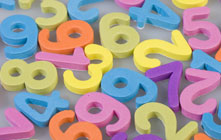Math Help: Creating a Number Line
When you're adding and subtracting positive and negative numbers, it's helpful to use a number line to visualize the operations. Read on to learn about different types of number lines and how to use them!

How to Make a Number Line
Number lines usually include both positive and negative numbers. You can just make a short number line to help you solve a problem with lower numbers, or you can make a long number line that wraps all the way around the walls of your classroom. Either way, the process is the same:
- Gather a piece of paper and a pencil, and then mark a dot in the center of the paper. This point will be the zero on your number line. Next, draw a horizontal line through the zero point.
- Working from zero and moving to the right, divide the line into equal sections and label them with the positive numbers (1, 2, 3…).
- Do the same thing on the left side of zero, this time labeling the marks with the negative numbers.
Variations
If you'd like to make your number line a bit more interesting, there are lots of creative options. Here are a few ideas:
- Make your number line vertical instead of horizontal, like a thermometer. The positive numbers go on the top half of the line (above zero), and the negative ones go on the bottom (below zero).
- Use colored pens or markers to decorate your number line. For example, positive numbers could be red, and negative numbers could be blue.
- Tailor your number line to the problem you're working on. For instance, if your math problem is about the distance a train is traveling, you could label your number line in miles and create a legend to show the directions.
Using Your Number Line
Now that you've made yourself a number line, you might need some instructions on how to use it. First, keep in mind that number lines are most helpful for adding and subtracting positive and negative numbers. Here's how to use your number line to solve this kind of problem:
- The first number in the problem is your starting point on the number line. For instance, if your problem is -5 + 7, then your starting point is negative five.
- The sign in the middle of your problem tells you which direction you need to go from the starting point. In the problem -5 + 7, the '+' sign tells you to go to the right. If it were a '-' sign, you'd move to the left.
- The second number in the problem tells you how many spaces on the number line you should go in the chosen direction. In our example problem, you go seven spaces to the right.
- The number that you land on is your solution. Since positive two (2) is seven spaces to the right of negative five (-5), the answer is two (-5 + 7 = 2).
Other Articles You May Be Interested In
-
Too Much Emphasis on Reading and Math?

According to a large number of surveyed educators who teach grades 3-12, U.S. public schools are spending too much time on reading and math and not enough on other subjects. Yes, math and reading are important. But what about science, foreign languages and social studies?
-
Easy As Pi: Introducing the Magic Number to Kids

The use of pi in mathematical equations dates back thousands of years. It was used in building the pyramids of ancient Egypt. It was also used by ancient cultures in Greece, India and China. This magical number has endured as a key math concept that kids need to learn. Fortunately, there are numerous ways to make studying pi...
We Found 7 Tutors You Might Be Interested In
Huntington Learning

- What Huntington Learning offers:
- Online and in-center tutoring
- One on one tutoring
- Every Huntington tutor is certified and trained extensively on the most effective teaching methods
K12

- What K12 offers:
- Online tutoring
- Has a strong and effective partnership with public and private schools
- AdvancED-accredited corporation meeting the highest standards of educational management
Kaplan Kids

- What Kaplan Kids offers:
- Online tutoring
- Customized learning plans
- Real-Time Progress Reports track your child's progress
Kumon

- What Kumon offers:
- In-center tutoring
- Individualized programs for your child
- Helps your child develop the skills and study habits needed to improve their academic performance
Sylvan Learning

- What Sylvan Learning offers:
- Online and in-center tutoring
- Sylvan tutors are certified teachers who provide personalized instruction
- Regular assessment and progress reports
Tutor Doctor

- What Tutor Doctor offers:
- In-Home tutoring
- One on one attention by the tutor
- Develops personlized programs by working with your child's existing homework
TutorVista

- What TutorVista offers:
- Online tutoring
- Student works one-on-one with a professional tutor
- Using the virtual whiteboard workspace to share problems, solutions and explanations